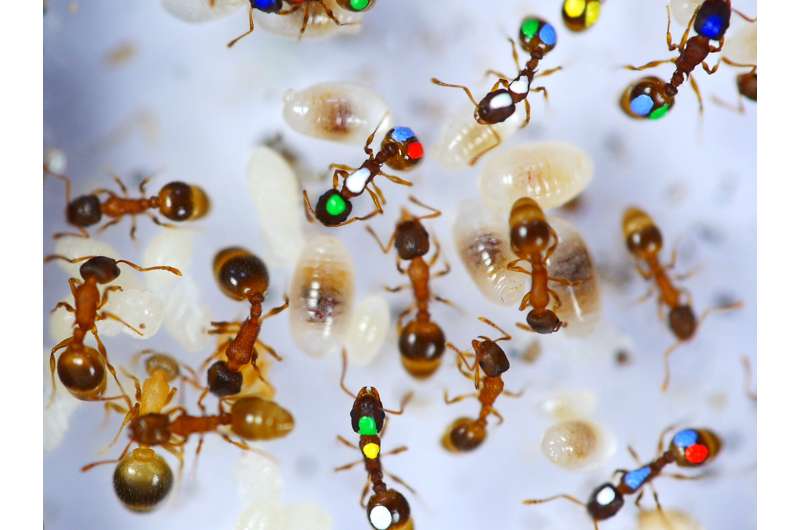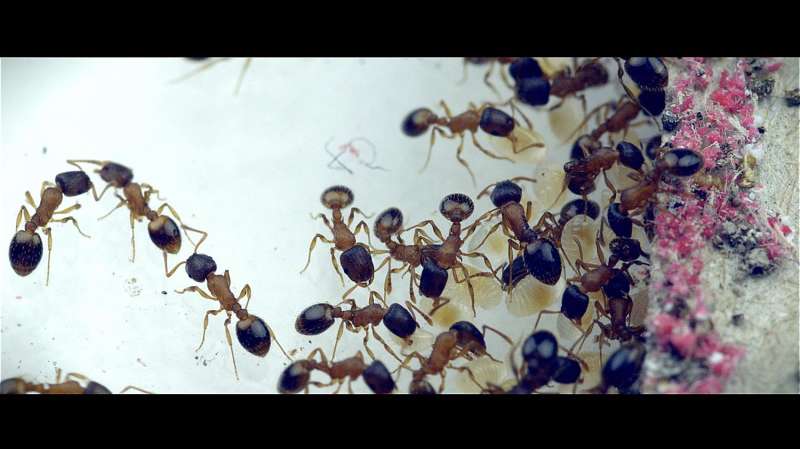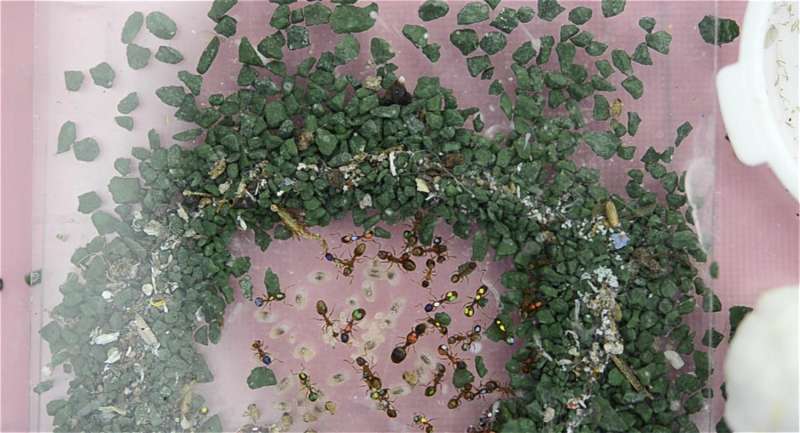Lazy ants make themselves useful in unexpected ways

If the first thing that comes to mind when you think about ants is "industrious," you might be in for a surprise. In 2015, biologists at the University of Arizona reported that a sizable chunk of the "workers" that make up an ant colony spent the vast majority of their day engaging in one task: doing absolutely nothing.
"They really just sit there," says Daniel Charbonneau, who dedicated his Ph.D. thesis to studying the behavior (or lack thereof) of these lazy ants. "And whenever they're doing anything other than doing nothing, they do chores around the nest, like a bit of brood care here or grooming another worker there."
Observing colonies of ants maintained in the lab, Charbonneau found that an average of 40 percent of individuals are mostly inactive, with some variation between seasons, colonies and species. And his ants, which belong to the species Temnothorax rugatulus, don't appear to be freaks of nature, Charbonneau says, as similar patterns can be observed in other social insects, even honey bees. Charbonneau and his doctoral adviser, Ecology and Evolutionary Biology Professor Anna Dornhaus, published those results in 2015. At the time, the researchers could only speculate over the purpose of keeping around hordes of inactive "workers."
In a new paper, published in the open-access journal PLOS ONE, authors Charbonneau, Takao Sasaki of the University of Oxford and Dornhaus show for the first time that inactive ants can act as a reserve labor force. When they removed the top 20 percent of most active workers, they found that within a week, they were replaced mostly by individuals belonging to the "lazy" demographic, which stepped up and increased their activity levels to match those of the lost workers.
"This suggests that the colony responds to the loss of highly active workers by replacing them with inactive ones," Charbonneau says.

"Serving as a replacement workforce is a long-held suspicion about the function of 'lazy' ants," adds co-author Dornhaus, "but it was just an assumption and never had been empirically confirmed."
Various functions—from serving as living food stores to laying eggs for consumption by their nest mates—had been suggested by other researchers, and Charbonneau investigated several of them through experiments involving marking individual ants in a colony and tracking their movements through video recordings.
"We apply tiny dots of paint to them," he explains. "One on head, one on thorax, and two dots on abdomen. The combination of colors and location identifies each individual, so we can track it in our video recordings."
In Arizona, colonies of this particular ant species are found at higher elevations—for example, on Mount Lemmon northeast of Tucson, where Dornhaus and her lab members go to collect them. Because the animals have rarely been studied in the wild, researchers don't know much about their life history, according to Charbonneau.
"We don't know how quickly their populations turn over in their natural habitat," he says, "but it doesn't take much for a colony to lose a bunch of workers. Since they can live for up to five years or more, they have to overwinter, and being snowed in claims many workers each season."

Analyzing the video recordings revealed that a colony breaks down into four main demographics, according to Charbonneau: inactive, lazy ants; so-called walkers that spend most of their time just wandering around the nest; foragers that take care of outside tasks such as foraging and building protective walls from tiny rocks; and nurses in charge of rearing the brood.
Charbonneau observed that the lazy ants tend to have more distended abdomens, hinting at the possibility that they could serve as "living pantries." Published in another recent paper, this observation awaits further testing to determine whether their larger circumference is a cause or a consequence of the lazier workers' lifestyle.
To see what would happen if the colony lost sizable amounts of inactive members, Charbonneau and Dornhaus did a separate experiment in which they removed the least active 20 percent. They found that those ants, unlike their top-performing peers, were not replaced.
"This suggests that workers are not switching from other task groups to replace the removed 'inactive' workers," the authors conclude, noting that the problem of adjusting supply to demand is not unique to social insects. From companies stocking supplies in warehouses to meet rising demand or employing contingent workers from external labor supply agencies, to computer systems performing better if equipped with reserve processing power, "the problem faced by all of these systems is how to optimally organize the supply or reserve workforce such as to minimize the costs of maintaining these reserves."
"My speculation is this: Since young workers start out as the most vulnerable members of the colony, it makes sense for them to lay low and be inactive," Charbonneau says. "And because their ovaries are the most active, they produce eggs, and while they're doing that, they might as well store food. When the colony loses workers, it makes sense to replace them with those ants that are not already busy pursuing other tasks."
More information: Daniel Charbonneau et al. Who needs 'lazy' workers? Inactive workers act as a 'reserve' labor force replacing active workers, but inactive workers are not replaced when they are removed, PLOS ONE (2017). DOI: 10.1371/journal.pone.0184074
Journal information: PLoS ONE
Provided by University of Arizona



















